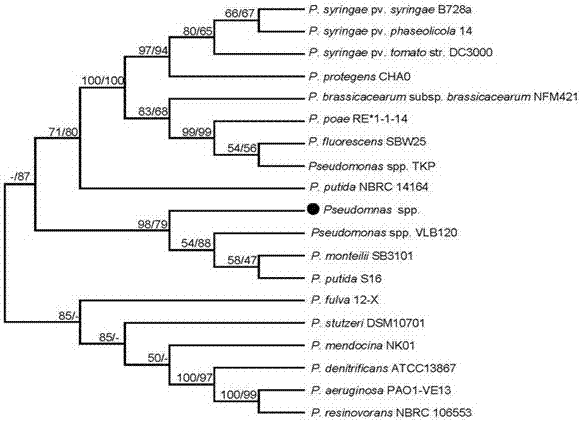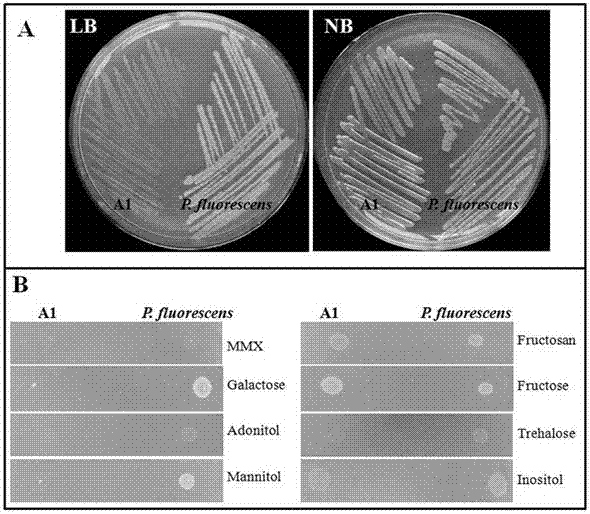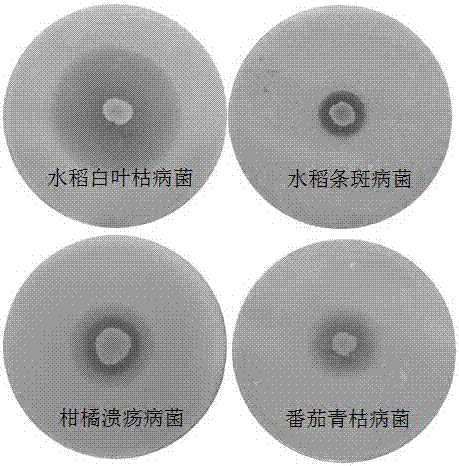Pseudomonas for bacterial disease control and application
A technology for Pseudomonas and disease control, applied in the biological field, can solve the problems of lack of control means and unsatisfactory control effect, and achieve the effect of ensuring soil quality, excellent control effect, and reducing residues
- Summary
- Abstract
- Description
- Claims
- Application Information
AI Technical Summary
Problems solved by technology
Method used
Image
Examples
Embodiment 1
[0016] (1) Isolation and identification of Pseudomonas A1
[0017] Soil samples were collected from a peanut planting site in Quanjiao County, Anhui Province, inoculated into enriched medium at an inoculum size of 3%, and propagated at 30°C for 12 hours; 2 mL of the supernatant was transferred to 10 mL of fresh NB medium Cultivate at 30°C for 24h. The enriched culture is plated with a gradient concentration, and a single colony of the bacterial culture in the culture medium is isolated, and one of the single colonies is the Pseudomonas strain of the present invention, named A1.
[0018] 16S rRNA universal primers (16SF: 5′-AGAGTTTGATCATGGCTCA-3′; 16SR: 5′-GGTACCTTGTTACGACTT-3′) were designed, and the genome of the isolated strain AH was extracted as a template to amplify the 16S rRNA sequence of the strain. The PCR amplification conditions were: 95°C / 5 min+(94°C / 45 sec+52°C / 30 sec+72°C / 1min30 sec)×33 cycles+72°C / 10min. The PCR product was sequenced and compared with the GenB...
Embodiment 2
[0020] Pseudomonas After sp. A1 was streak cultured on NB and LB solid media, there was no obvious polysaccharide production, and the colony color was dark brown. Because it grows relatively well on NB solid plates, the color is slightly darker. The Pseudomonas fluorescens cultured at the same time was off-white in NB and LB. It is precisely because of the special colony growth color of the isolated strain that it has attracted attention ( figure 2 A). In minimal medium MMX, the isolated strain could not use galactose, mannitol or aditol as the sole carbon source, but it had the ability to assimilate fructan, fructose, inositol and trehalose ( figure 2 B). The strains grew fastest on MMX medium containing fructose and fructans, probably the most efficient carbon source. Pseudomonas fluorescens in parallel experiments could utilize galactose, mannitol or aditol in addition to fructan, fructose, inositol and trehalose, indicating that the isolated strain was not exactly...
Embodiment 3
[0022] (1) Antibacterial effect of Pseudomonas on several plant pathogenic bacteria
[0023] Liquid cultivation of phytopathogenic bacteria in rich media: Xanthomonas oryzae ( Xanthomonas oryzae pv. oryzae ), Rice streak disease ( Xanthomonas oryzae pv. oryzicola ), Canker sorrel citrus ( Xanthomonas citri subsp. citri ) and Ralstonia solanacearum ( Ralstonia solanacearum ), adjust the OD600 value of the cultured bacterial solution to 1.0. Before preparing the plate, add it to the NA medium at a ratio of 1:100, shake well and make a plate with bacteria. Add 2 μl of Pseudomonas solution (OD 600 =1.0); after static culture at 28°C for 48 hours, observe the size of the inhibition zone ( image 3 ). The results showed that the A1 strain had obvious inhibitory effects on the four tested strains.
[0024] (2) Control effect of Pseudomonas A1 on tomato bacterial wilt
[0025] At the 5-6 leaf stage, a knife wound was made at 1 cm from the root of the tomato plant,...
PUM
 Login to View More
Login to View More Abstract
Description
Claims
Application Information
 Login to View More
Login to View More - R&D
- Intellectual Property
- Life Sciences
- Materials
- Tech Scout
- Unparalleled Data Quality
- Higher Quality Content
- 60% Fewer Hallucinations
Browse by: Latest US Patents, China's latest patents, Technical Efficacy Thesaurus, Application Domain, Technology Topic, Popular Technical Reports.
© 2025 PatSnap. All rights reserved.Legal|Privacy policy|Modern Slavery Act Transparency Statement|Sitemap|About US| Contact US: help@patsnap.com



